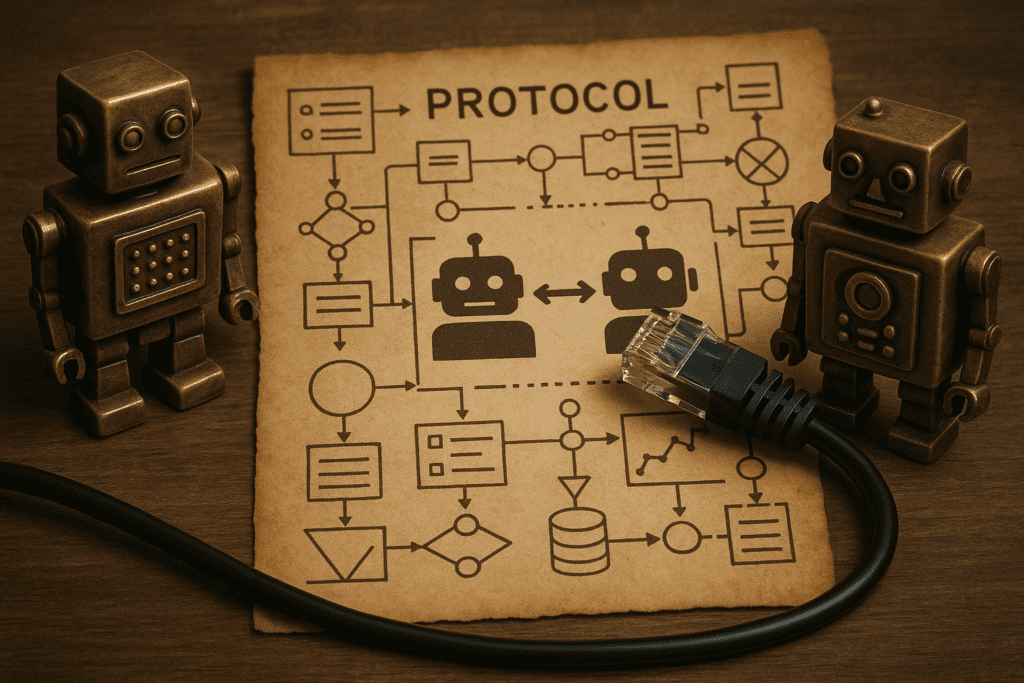Google’s A2A, the Emerging AI Stack, and the Enterprise Advantage of Going Open
Software’s new frontier isn’t bigger models—it’s how those models communicate. Google’s A2A protocol, Microsoft’s fast embrace, and fresh entries like IBM’s ACP signal a shift from isolated bots to cross-cloud ecosystems where agents plug in like APIs. Boards want that portability, compliance wants audit trails, and developers want a URL, not a months-long integration. The following brief maps past open-standards revolutions onto today’s agentic stack and shows how Intelagen turns protocol fluency into immediate go-to-market advantage.
1. From Dial‑Up Packets to Digital Ecosystems: Lessons of the Open‑Standards Era
Every major inflection in computing has been propelled by a common, openly governed protocol layer. When the Internet Protocol Suite (TCP/IP) was standardized in 1982, it demilitarized ARPANET technology and made “network of networks” more than a slogan; it became an executable contract between machines that anyone could implement. That neutrality dissolved vendor silos, triggered the browser boom, and created an entire software economy atop packet routing — from e‑commerce to mobile apps.
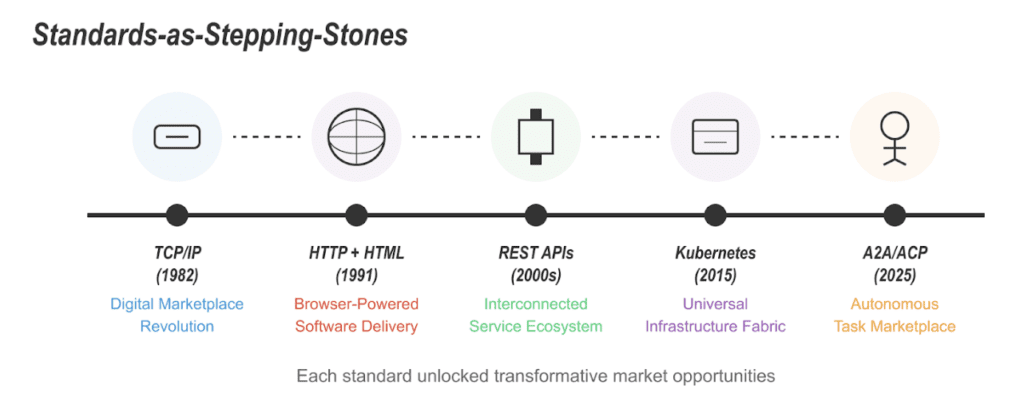
The pattern repeated: HTML and HTTP standardized the Web, RESTful APIs unlocked mash‑ups and SaaS, Kubernetes normalized container orchestration, and GraphQL reframed data access. In each case, openness expanded the design space faster than any single vendor could. The result was not merely bigger markets but entirely new markets, because interoperability converts technical possibility into shared infrastructure.
2. Enter A2A: A Common Language for Autonomous Agents
We are at a similar hinge point today. Modern enterprises no longer debate whether they will use AI agents but how many and how they will talk. Chatbots triage support tickets, orchestration agents schedule supply chains, autonomous research agents mine unstructured data. Each solves a local problem, yet the real value lies in chaining them together so that context, not code, flows between domains.

Google’s newly open‑sourced Agent‑to‑Agent (A2A) protocol is designed for precisely that role. A2A is a lightweight, JSON‑RPC–based specification that lets agents advertise capabilities (“I can summarize legal documents”), request services, and exchange structured context over standard HTTP. Unlike point integrations, A2A assumes heterogeneity: agents may run on different clouds, languages, or vendors, yet still negotiate tasks through a shared schema.
3. Microsoft’s Early Move: Semantic Kernel Speaks A2A
Standards matter only when multiple ecosystems bet on them, which is why Microsoft’s decision to add native A2A support to the open‑source Semantic Kernel (SK) framework is so significant. SK agents can now register as A2A servers, delegate subtasks to peer agents, and return results without sharing credentials or code artifacts. In other words, SK becomes a first‑class citizen in Google’s interoperability fabric while remaining fully at home on Azure. citeturn0search4
This cross‑cloud handshake echoes the early Web services era, when WSDL and SOAP gave way to REST precisely because every provider could implement it. A2A is following the same playbook, but for autonomous cognition instead of HTTP verbs.
4. A Constellation Forms: AWS, Postman—and Now IBM’s ACP
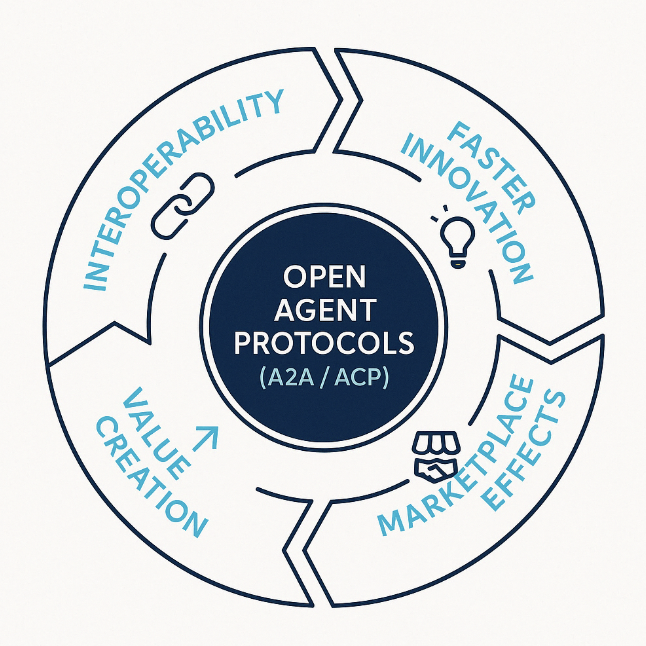
Amazon’s strategic advantage has always been developer gravity: S3’s simple REST API, Lambda’s event model, and most recently Bedrock’s multi‑model endpoint strategy. History suggests AWS will not cede inter‑agent plumbing to competitors. Adopting A2A (or offering an A2A‑compatible façade) aligns perfectly with its pattern of embracing open interfaces while differentiating on reliability and scale. Expect an A2A‑ready “AWS Agent Mesh” announcement sooner than later.
Developer tooling is moving just as quickly. Postman, the ubiquitous API collaboration suite, has already embraced Anthropic’s Model Context Protocol (MCP) and now ships an open‑source MCP server. The logical next step is A2A collections; once that happens, 25 million API engineers will treat agent integration as naturally as REST mocking.
Hot on their heels, IBM Research has published a draft Agent Communication Protocol (ACP). Built atop MCP and JSON‑RPC, ACP tackles many of the same pain points as A2A: capability discovery, context exchange, and UI‑oriented metadata. IBM’s approach is intentionally “running code first, standards second,” inviting community feedback through the BeeAI project and Linux Foundation governance.
Together, Google’s A2A, Postman’s embrace of MCP, and IBM’s ACP draft mark a tipping point: agent interoperability is no longer speculative—it’s becoming infrastructural. What began as a technical proposal is now a full-blown GTM engine, with Google rewiring its sales culture around A2A-compliant agent marketplaces and mandatory co-selling. For Intelagen, this means unprecedented leverage: instant visibility via Marketplace listings, executive access through Google field teams, and future-proofed deployments that can scale across clouds. The convergence of open protocols and platform incentives is transforming agent ecosystems from isolated experiments into composable, revenue-generating infrastructure.
5. Intelagen × Unframe: Rapid Enterprise AI PoCs That Scale Through Standards
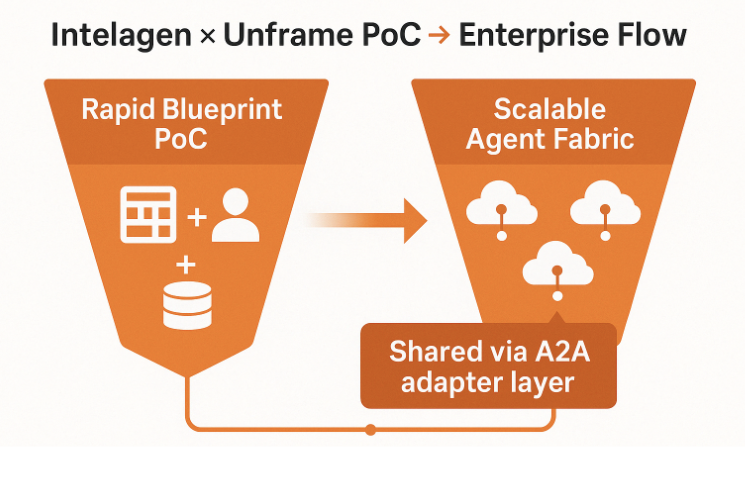
At Intelagen, we live in the trenches where executives demand business impact this quarter, not next fiscal year. Our partnership with Unframe embodies that urgency. Unframe’s “Blueprint” approach can spin up tailored AI solutions in days, but customers inevitably worry about long‑term lock‑in once a PoC shows value. By ensuring every Blueprinted agent speaks A2A—and remains adapter‑ready for ACP—we convert prototype speed into enterprise resilience: the same agent that proves a concept on Google Cloud can later be orchestrated by a Semantic Kernel workflow on Azure or an (eventual) AWS agent mesh with no refactor. That is the difference between a demo and a platform.
6. From Workflows to Negotiating Collectives
Most organizations still model processes as linear workflows: step A triggers step B, which calls system C. Agent ecosystems invert that view. Each agent exposes intents and competencies; orchestration emerges dynamically as agents query one another for the best service to fulfill a goal. Protocols like A2A—and potentially ACP—formalize the handshake, allowing agents to:
- Compose capabilities on the fly (“Find an expert‑grade summarizer and a domain‑aware translator, chain them, then feed the result to my compliance checker”).
- Negotiate on quality‑of‑service (“I need real‑time SLA; who can meet it at this cost?”).
- Execute across organizational and cloud boundaries without brittle point‑to‑point APIs.
The shift mirrors market economies: once actors can publish services and contracts cheaply, specialization and trade explode. We should therefore expect agent economies to emerge — marketplaces where agents pay or barter for skills, data, and compute time.
7. Strategic Implications for the Enterprise Stack
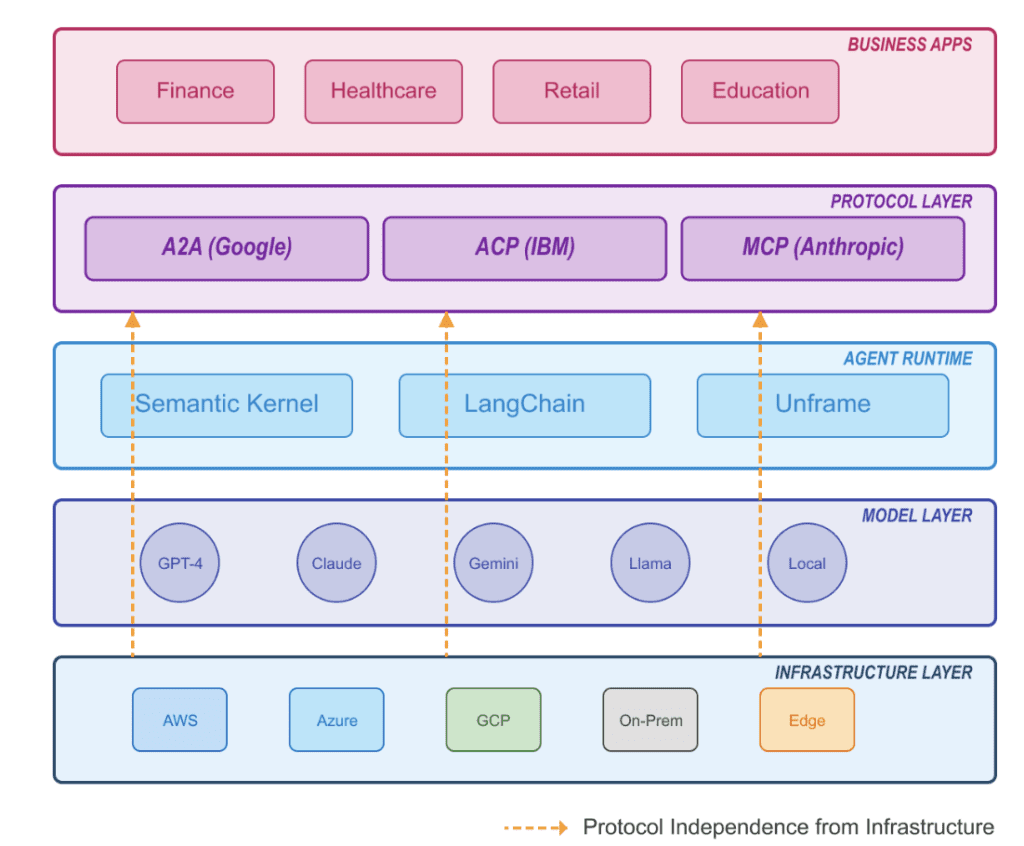
- Governance by Interface, Not Vendor. Open protocols decouple strategic control from infrastructure choices. Enterprises can impose policy layers (security, auditing, cost) at the A2A or ACP gateway rather than inside every agent runtime.
- Faster Innovation Loops. Composability becomes the default state; experimenting with a new capability is literally a URL swap, not a three‑month integration project.
- Reduced Shadow‑IT Risk. When business units can register approved agents to a shared directory, ad‑hoc automations become observable assets rather than rogue scripts.
- Cross‑Cloud Leverage. Open protocols exploit whichever hyperscaler offers the best model or price at any given moment, neutralizing one‑provider dependency.
Emergent Network Effects. As more agents speak A2A, ACP, or compatible bridges, the value of any single agent rises because its potential collaborations multiply.
8. A Call to Action
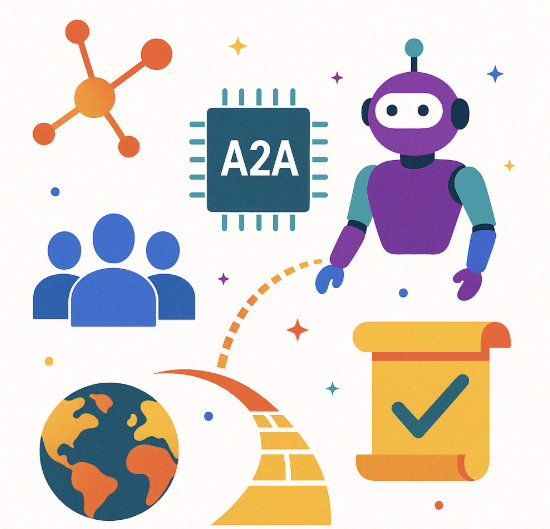
Open agent standards are not a nice‑to‑have future feature; they are the infrastructure layer the AI era requires now. The companies that led the last platform waves were the ones who adopted TCP/IP stacks before their competitors understood why email mattered. The same will be true for A2A—whether it fully absorbs ACP, coexists, or evolves into something new.
At Intelagen, we aren’t waiting for the standards to settle. We’re helping clients build with them now. Here’s how:
- Protocol Compliance, Baked In
Every client PoC includes pre-wired support for A2A and MCP—and where ACP shows immediate utility, we extend adapters to support it. No lock-in, just future-proofing. - Delivery-First Integrations
Instead of contributing specs, we’re packaging them. Our clients get turnkey components, validation workflows, and rapid-deploy modules—ready to ship into production. - Agent Directory Enablement
We curate an activation-ready library of agents, toolchains, and protocol-aware services that clients can immediately plug into. Think App Store for interoperable AI.
We invite developers, CIOs, and platform vendors to join us. Test the specs, file issues, demand protocol roadmaps from your cloud providers, and share lessons learned. Interoperability is not charity; it is a flywheel that compounds value for everyone who participates.
The first packets of TCP/IP traversed ARPANET almost unnoticed — yet they birthed the modern digital world. The first A2A and ACP messages are already traversing clouds. Let’s ensure they carry not just data, but the blueprint for the next economy of intelligent, collaborative agents.
Agentic infrastructure isn’t a moonshot—it’s your next sprint.
Let Intelagen show you how to harness open protocols to drive results, faster.
About the Author
Nicky Clarke is Intelagen’s Chief AI Officer and based in Florida. He has over 25 years of experience in the technology consulting space and has previously worked at Deloitte, Microsoft, Wipro, and HCL.
